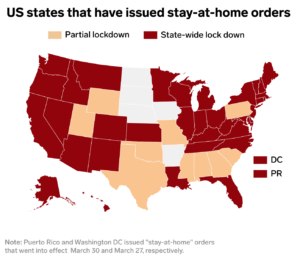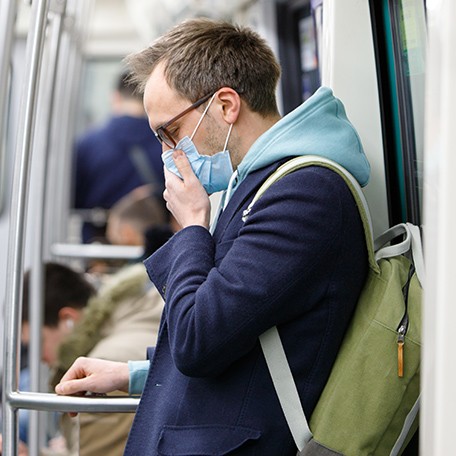The Trump Administration announced this week it is officially extending its guidance on social distancingsocial distancing :the avoidance of close contact with other people during the outbreak of a contagious disease in order to minimize exposure and reduce the transmission of infection. to April 30 to stem the spread of the Coronavirus in the United States. With more than 800,000 cases worldwide, there are currently more than 162,000 known cases of the novel coronaviruscoronavirus co·ro·na·vi·rus : any of a family (Coronaviridae) of single-stranded RNA viruses that have a lipid envelope studded with club-shaped projections, infect birds and many mammals including humans, and include the causative agents of MERS, SARS, and COVID-19 in the United States, with more than 3,000 fatalities to date. The U.S. COVID-19COVID-19 \ ˈkō-vid-nīn-ˈtēn : a mild to severe respiratory illness that is caused by a coronavirus (Severe acute respiratory syndrome coronavirus 2 of the genus Betacoronavirus), is transmitted chiefly by contact with infectious material (such as respiratory droplets), and is characterized especially by fever, cough, and shortness of breath and may progress to pneumonia and respiratory failure. death toll for the first time exceeded 700 in one day, according to data compiled by The Washington Post.
Other guidance under “very active discussion” by the White House’s coronavirus task force is the use of masks in the US to prevent airborne Coronavirus contamination, Dr. Anthony Fauci, head of the task force, told CNN. The recommendation runs counter to the current Centers for Disease Control and Prevention (CDC) directive that masks aren’t necessary for most people and World Health Organization directive that only people sick or caring for someone with COVID-19 wear masks. Fauci also predicted another outbreakoutbreak out·break | \ ˈau̇t-ˌbrāk : a sudden, rapid rise in the incidence of a disease could occur in the fall.
Social Distancing Guidelines May Be Inadequate
That news comes on the heels of a new study at MIT that indicates that social distancing guidelines to stay six feet from others may be inadequate. Pathogen-bearing droplets of all sizes can travel 23 to 27 feet, according to the research by MIT Professor Lydia Bourouiba, which was published in the Journal of the American Medical Association. Residues or droplet nuclei “may stay suspended in the air for hours,” the study reports. The research noted a 2020 report from China that showed that “virusvirus vi·rus | \ ˈvī-rəs : a disease-causing agent that is too tiny to be seen by the ordinary microscope, that may be a living organism or may be a very special kind of protein molecule, and that can only multiply when inside the cell of an organism particles could be found in the ventilation systems in hospital rooms of patients with COVID-19.”
“There’s an urgency in revising the guidelines currently being given by the WHO and the CDC on the needs for protective equipment, particularly for the frontline health care workers,” Bourouiba told USA Today.
Statewide Restrictions
Today, more than 32 states have enacted restrictions to manage the outbreak. On Monday, a stay at home order was issued in Maryland and Virginia, which extended the order through June 10, making it one of the longest statewide mandates implemented so far. A number of states have instituted fines to enforce the new restrictions.

U.S. Coronavirus Hotspots
Several states are considered current epicenters for COVID-19 disease:
- New York City this week surpassed 75,000 cases and 3,000 deaths due to COVID-19.
- Louisiana has the highest death rate from COVID-19 in the nation. Some 40% of adults over 18 living in the state have pre-existing conditions such as diabetes, high blood pressure, cardiovascular disease or chronic renal disease. The state’s reported cases topped 5,200 with 239 deaths and more than 1,000 hospitalized due to the disease. More than 1,800 of the cases are in New Orleans, and the virus had spread to 60 of 64 parishes.
- Washington State has recorded just shy of 5,000 cases, and the state’s infectioninfection in·fec·tion | \ in-ˈfek-shən a : the state produced by the establishment of one or more pathogenic agents (such as a bacteria, protozoans, or viruses) in or on the body of a suitable host b : a disease resulting from infection rate is on a strong upward trajectory due to both community transmissioncommunity transmission : the spread of a contagious disease within a community specifically : the spread of a contagious disease to individuals in a particular geographic location who have no known contact with other infected individuals or who have not recently traveled to an area where the disease has any documented cases and increased testing.
- The captain of the USS Theodore Roosevelt, a U.S. Navy nuclear aircraft carrier stationed in Guam, is requesting resources to allow isolation of his entire crew of more than 4,000 members after more than 100 sailors were found to be infected with the coronavirus. The extraordinary request was made because “self-isolationself-isolation self-iso·la·tion | \ ˌself-ˌī-sə-ˈlā-shən : the act of isolating or separating oneself or itself from others. is impossible due to the warship’s inherent limitations of space,” Capt. Brett Crozier wrote in a letter to his commanders.
- Michigan has reported more than 7,000 cases.
- The U.S. Coast Guard has directed all cruise ships to remain at sea where they may be sequestered “indefinitely” during the coronavirus pandemicpandemic (pan·dem·ic) : an outbreak of a disease that occurs over a wide geographic area and affects an exceptionally high proportion of the population : a pandemic outbreak of a disease. and to send any sick passengers to the countries where their vessels are registered. Carnival Cruise Lines has more than 6,000 passengers still at sea.


No comments yet. Be the first one to leave a thought.